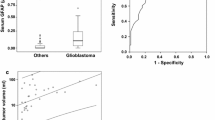Abstract
Myxopapillary ependymoma (MPE) is a rare tumor of the distal spinal cord. Despite benign histopathology, local recurrences occur in ~30 % of patients and distant metastases have been described in few cases. MPE tumor cells typically express glial fibrillary acidic protein (GFAP), which could be released to the circulation. In this current report, we investigated circulating plasma-GFAP in a series of MPE patients. We analyzed circulating plasma-GFAP using a commercially available ELISA kit in 3 patients with completely resected MPE, 1 patient with locally advanced MPE and 2 patients with pleuropulmonary metastases of MPE. As controls we used blood samples of age and gender-matched healthy volunteers (n = 3), 6 glioblastoma patients with known plasma-GFAP status (positive for 3 and negative for 3 patients) and 3 brain metastases patients with known plasma-GFAP negativity. We found very high concentrations of plasma-GFAP in two MPE patients with pleuropulmonary metastases, while in none of the other MPE patients circulating plasma-GFAP was detectable. Circulating GFAP could be useful as marker for early detection or follow-up of distant metastases in MPE patients.


Similar content being viewed by others
References
Aurell A, Rosengren LE, Karlsson B, Olsson JE, Zbornikova V, Haglid KG (1991) Determination of S-100 and glial fibrillary acidic protein concentrations in cerebrospinal fluid after brain infarction. Stroke 22:1254–1258
Brommeland T, Rosengren L, Fridlund S, Hennig R, Isaksen V (2007) Serum levels of glial fibrillary acidic protein correlate to tumour volume of high-grade gliomas. Acta Neurol Scand 116:380–384
Eng LF, Ghirnikar RS, Lee YL (2000) Glial fibrillary acidic protein: GFAP-thirty-one years (1969–2000). Neurochem Res 25:1439–1451
Foerch C, Curdt I, Yan B, Dvorak F, Hermans M, Berkefeld J, Raabe A, Neumann-Haefelin T, Steinmetz H, Sitzer M (2006) Serum glial fibrillary acidic protein as a biomarker for intracerebral haemorrhage in patients with acute stroke. J Neurol Neurosurg Psychiatry 77:181–184
Ilhan-Mutlu A, Wagner L, Widhalm G, Wohrer A, Bartsch S, Czech T, Heinzl H, Leutmezer F, Prayer D, Marosi C, Base W, Preusser M (2013) Exploratory investigation of eight circulating plasma markers in brain tumor patients. Neurosurg Rev. doi:10.1007/s10143-012-0401-6
Ilhan A, Furtner J, Birner P, Rossler K, Marosi C, Preusser M (2011) Myxopapillary ependymoma with pleuropulmonary metastases and high plasma glial fibrillary acidic protein levels. J Clin Oncol. 29:e756–e757
Ilhan I, Berberoglu S, Kutluay L, Maden HA (1998) Subcutaneous sacrococcygeal myxopapillary ependymoma. Med Pediatr Oncol 30:81–84
Jung CS, Foerch C, Schanzer A, Heck A, Plate KH, Seifert V, Steinmetz H, Raabe A, Sitzer M (2007) Serum GFAP is a diagnostic marker for glioblastoma multiforme. Brain 130:3336–3341
Louis DN, Ohgaki H, Wiestler O, Cavenee W (2007) WHO classification of tumours of the central nervous system, 4th edn. Blackwell, Oxford
Notturno F, Caporale CM, De Lauretis A, Uncini A (2008) Glial fibrillary acidic protein: a marker of axonal Guillain–Barre syndrome and outcome. Muscle Nerve 38:899–903
Husain H, Savage W, Grossman SA, Ye X, Burger PC, Everett A, Bettegowda C, Diaz LA Jr, Blair C, Romans KE, Holdhoff M (2012) Pre- and post-operative plasma glial fibrillary acidic protein levels in patients with newly diagnosed gliomas. J Neurooncol 109:123–127
Pica A, Miller R, Villa S, Kadish SP, Anacak Y, Abusaris H, Ozyigit G, Baumert BG, Zaucha R, Haller G, Weber DC (2009) The results of surgery, with or without radiotherapy, for primary spinal myxopapillary ependymoma: a retrospective study from the rare cancer network. Int J Radiat Oncol Biol Phys 74:1114–1120
Weber DC, Li J, Miller R, Villa S, Anacak Y, Poortmans P, Baumert B, Pica A, Ozyigit G, Preusser M (2012) Outcome of patients with primary spinal myxopapillary ependyomama: a retrospective study from the MD Anderson Cancer Center and Rare Cancer Network. EANO 10th meeting, Marseille/France, September 2012
Acknowledgments
We thank all patients and our colleagues Dr. Roland Hansen (Aachen, Germany) and Dr. Mila Petrova (Sofia, Bulgaria) for their support and cooperation.
Conflict of interest
The authors declare no conflict of interest with regard to the content of the manuscript.
Author information
Authors and Affiliations
Corresponding author
Rights and permissions
About this article
Cite this article
Ilhan-Mutlu, A., Berghoff, A.S., Furtner, J. et al. High plasma-GFAP levels in metastatic myxopapillary ependymoma. J Neurooncol 113, 359–363 (2013). https://doi.org/10.1007/s11060-013-1134-2
Received:
Accepted:
Published:
Issue Date:
DOI: https://doi.org/10.1007/s11060-013-1134-2




